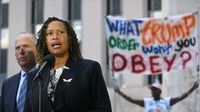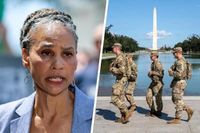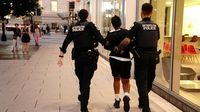When President Donald Trump announced a sweeping federal takeover of Washington, D.C. on August 28, 2025, citing a surge in youth crime as justification, the move set off a wave of debate across the city and the nation. Trump’s vision—described as a necessary response to “caravans of mass youth rampage through city streets”—brought thousands of National Guard soldiers and federal agents to the capital’s avenues, but the reality on the ground is far more complicated than the grim picture painted from the Oval Office.
Local experts and community leaders argue that the president’s approach is more about political theater than practical public safety. Nick Wilson, senior director for Gun Violence Prevention at the Center for American Progress, told TIME, “We know it takes deep intelligence-led policing, deep community engagement, deep partnerships, bringing in hospitals and schools and the community to work together, to focus on the people in places that are at the highest risk of violence. The number of youth arrested committing violence and crimes has fallen. Now is not the time to switch gears and just have cops and troops in tourist areas, just for show.”
Indeed, the city has struggled with youth crime, particularly following the COVID-19 pandemic. In 2023, police reported around 957 carjackings—most committed by individuals under 18. The aftermath of pandemic-induced school closures led to a spike in truancy and, subsequently, youth-involved crime. In 2024, 29 young people were killed by gunfire in the city, and by 2025, the number of under-18s struck by gunfire had risen slightly, according to U.S. Attorney Jeannine Pirro. But D.C. police data also reveals a more hopeful trend: juvenile arrests in 2025 dropped by 20% from the previous year, landing at 900 arrests.
Community organizations like TRIGGER, led by Tia Bell, have been at the forefront of tackling gun violence by focusing on its root causes. Bell’s nonprofit runs a six-week summer program that offers employment, conflict mediation, and trauma support to young people—especially crucial during the summer months when violence typically spikes. “It starts with personal development. We learn a lot about the students and their goals and their greatness first, and then we go deeply into the root causes of gun violence,” Bell told TIME. She believes that addressing gun violence as a public health issue—treating it like a disease—offers the only viable solution. “Federal violence cannot end violence in the communities—only we can,” she said.
Research backs up the impact of these community-based interventions. A report by the Center for American Progress earlier this year credited investments in violence prevention programs like TRIGGER for the recent decline in youth crime. Yet, in a move that has frustrated advocates, the Department of Justice halted funding for such initiatives earlier in 2025, affecting 10 to 15 organizations in D.C. alone. One, Peace For D.C., lost over $700,000 in federal support for its Heal DC program for both 2025 and 2026.
Despite these setbacks, the city’s leadership has tried to balance the federal presence with local priorities. Mayor Muriel Bowser, who once called the federalization of D.C.’s police force an “authoritarian push,” struck a more conciliatory tone after a recent meeting with Trump. She praised the “federal surge” for helping to reduce illegal guns, carjackings, and homicides, and even pledged support for Trump’s $2 billion request to beautify D.C. parks, fountains, and streets. “We think that there’s more accountability in the system, or at least perceived accountability in the system, that is driving down illegal behavior,” Bowser said at a press conference, according to Axios.
The data appears to support some of these claims. Over the 20-day period following the federal crackdown, carjackings reportedly dropped by 87% compared to the same time last year, and overall crime declined by 15%. The city’s official database shows a 44% decrease in violent crime during the three weeks since the federal surge began, compared to the same period in 2024, and a 28% drop compared to the three weeks before the surge. Homicides fell by 44% year-over-year for the same period.
Yet, Bowser has not shied away from criticizing aspects of the federal intervention. She specifically called out the deployment of masked Immigration and Customs Enforcement (ICE) agents and National Guard troops from other states as inefficient and damaging. “Masked ICE agents have not worked,” Bowser said, and she described the out-of-town National Guard presence as an “inefficient use of those resources.” Experts estimate the ongoing National Guard deployment is costing roughly $1 million per day, as reported by CNN.
Bowser also acknowledged the “break in trust between police and community” that has emerged as local officers team up with federal agencies. “I am devastated by people living in fear,” she said, noting the “tremendous anxiety in the District.” D.C.’s sanctuary city status has come under renewed scrutiny amid increased cooperation with immigration authorities, but Bowser insisted, “There’s been no change to the law,” nor to the city’s “sanctuary values.”
The mayor’s nuanced stance—supporting certain federal investments while criticizing others—has drawn criticism from local politicians. Councilmember Zachary Parker, for example, called on city leaders to be “unequivocal” in their opposition to the federal surge. Meanwhile, public opinion is largely skeptical. A Washington Post-Scar School poll found that 79% of D.C. residents opposed Trump’s actions, with 65% doubting that the moves would actually reduce violent crime. A Reuters/Ipsos poll found only 36% of Americans support federal control over D.C.’s police and just 38% back the deployment of out-of-state National Guard troops for law enforcement.
Experts warn of the long-term costs of hyperpolicing. Eduardo Ferrer, Policy Director at the Georgetown Juvenile Justice Clinic, told TIME that increased military presence only adds to the trauma many young people already experience. Professor Paul Boxer of Rutgers University added, “There’s plenty of research on this—that when kids do have encounters with law enforcement... it doesn’t end well for the kids.” Research shows that such encounters can heighten psychological distress, predict disengagement from school, and foster alienation—especially among youth of color.
Bowser, for her part, has outlined long-term solutions focused on local control: recruiting 500 new Metropolitan Police Department officers, hiring more prosecutors and judges, and investing in prevention programs and homeless services. She also highlighted the Department of Transportation’s takeover of Union Station, calling the planned transformation “a very significant and good investment for this region.”
As D.C. navigates the aftermath of Trump’s federal takeover, the city finds itself at a crossroads—balancing the immediate impact of a federal crackdown with the need for sustainable, community-driven solutions. The debate over how best to keep the capital’s streets safe is far from over, but one thing is clear: the voices of those who live and work in D.C. are demanding to be heard.






